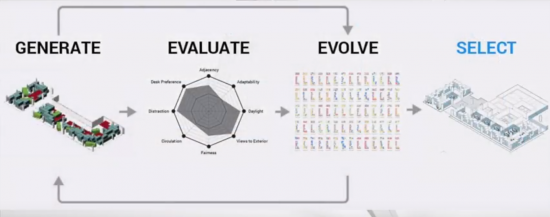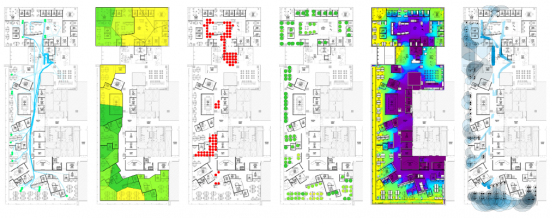The Living team uses generative design technology for architectural space planning in Autodesk Toronto office.
Computation power is at the heart of generative design process that tries to adapt patterns from nature into design tools. Generative design focuses on developing interactive process that a designer can engage with to create dynamic solutions that are otherwise unthinkable by a human brain. A computer can come up with hundreds to millions different solutions to our well-defined problems.
It was in 2003, when Bentley introduced Generative Components (GC, commercially released in 2007). It was built on top of MicroStation. The technology caused quite a stir among architectural design firms that were facing advance design problems. To further promote the technology, Robert Aish, known as father of Generative Components (GC) technology, founded SmartGeometry Organization, in assistance with Hugh Whitehead of Foster + Partners, Lars Hesselgren, and J. Parish of Arup Sport. The SmartGeometry Group is an independent non-profit organization. Every year, global community of SmartGeometry Group comes together to promote the emerging technologies in AEC, push current design practices, and create something new in a fun way. Next SmartGeometry event is set to explore the impact of computational intelligence on the future of architectural design.
In 2006, Carl Bass stepped up as CEO of Autodesk. People asked him how he wanted to define Autodesk. He would answer simply: “great, good and important.” Autodesk’s ability to be a tool maker for designers, manufacturers, and makers has realized his vision of making Autodesk important. During his tenure, Autodesk was expanding through acquisitions and development of new products. Work on BIM and generative design technologies was under progress. In 2008, Robert Aish left Bentley and joined Autodesk. It gave Robert Aish considerable opportunities to spread generative design technology among Autodesk applications users. Similarly, Autodesk was building applications on this powerful technology that would be easier to use (as compared to GC in Bentley products).
Autodesk acquired New York design studio The Living in 2014. Headed by David Benjamin, The Living was exploring new design methods and materials born of living organisms and natural structures. Today, The Living team builds contextual projects using generative design, synthetic biology, and new materials.
Generative design for architecture can solve issues beyond form and structure. This data-driven designing involves more complex goals and constraints as inputs. Infinite computation, available through cloud, can bring a number of architectural solutions. And the best ones will help in designing the available space like no other architect can!
Project MaRS
At AU 2016, David Benjamin presented a short presentation about how The Living was using AI to design Autodesk’s Toronto office at MaRS Discovery District.

Project Discover offers a workflow for generative design that applies to architectural space planning. Six unique objectives were designed that evaluated each layout based on architectural performance and were in accordance of employees’ likings (as described by them in a survey before the project started). The design metrics were: adjacency preference, work style preference, buzz, productivity, daylight, and views to the outside.

After setting metrics, constraints were defined for the provided architectural space. Basically a geometric system was designed that generated almost 10,000 design options by varying input parameters provided by 250 employees of the Autodesk Toronto office. A multi-objective genetic algorithm (MOGA) explored the possible solutions and came up with high-performance designs.
Autodesk Toronto office has officially opened at MaRS Discovery District in September 2017.
Recently, GraphicSpeak talked to Azam Khan, Director of Complex Systems Research at Autodesk, about Project Discover.

Q: What revelations came out of this work?
A: The metrics could be applied to existing designs, so it becomes possible to compare a generated design to a traditional design. The generative design process forces humans to quantify things that would otherwise be qualitative. Developing designer intuition is still a challenge.
Q: Apart from the fact that employees got their desired conditions at workplace, what other benefits were realized? Why couldn’t it have been done through conventional means?
A: Generative design mixes human intelligence with machine intelligence. For the new Autodesk Toronto office, it created 10,000 different office layouts. Collecting and using detailed input from 250 employees would have been far too complicated and expensive to accommodate through conventional means.
Q: How will the lessons learned be incorporated into Autodesk’s products or services?
A: The lessons learned from developing Project Discover will be implemented in Autodesk Dynamo Studio and Project Fractal (https://home.fractal.live/) by the architecture, engineering, and construction (AEC) team.
Q: It sounds interesting to know that layout of AU 2017 exhibit hall has been designed using generative design technology. Could you please tell us more about it?
A: We developed a novel simulation method, for Project Discover, for measuring the amount of buzz or “productive congestion” in an interior architectural space. This “buzz metric” first predicts the amount and distribution of congestion based on a simulation of walking paths and, then, computes the extent this congestion is distributed across the space. Unlike dynamic methods for simulating occupant behavior such as agent-based crowd simulation, our method is computed statically, and is fast enough to be used in a multi-objective optimization workflow. Then we use this result in an automated generative design process for the design of the Autodesk University 2017 exhibit hall.
What do we think?
Autodesk was not the first to use generative design concept in its products. Neither is it alone. Many other vendors like Bentley and Robert McNeel are practicing this technology in their product offerings. But Autodesk has resources and has shown real commitment to this technology with time, simplifying its usage in the products and related industries.
Happy AU next week!





